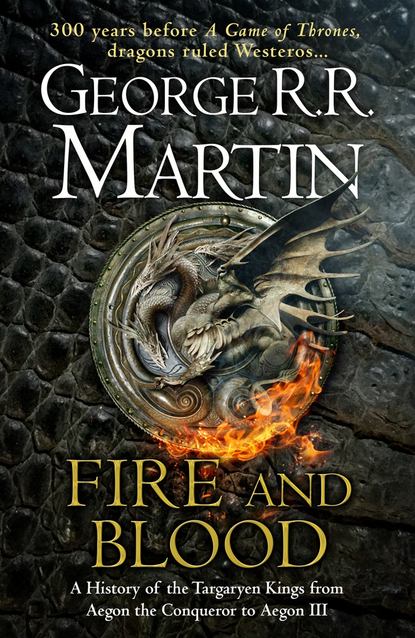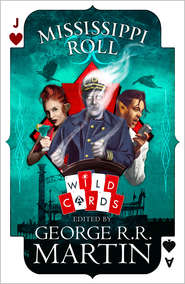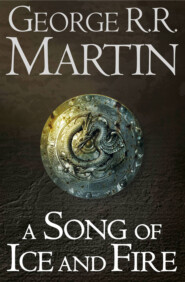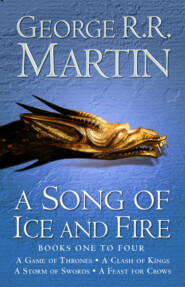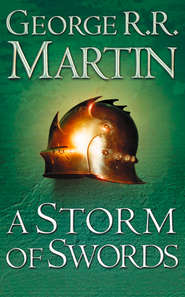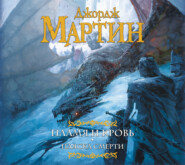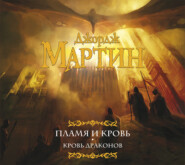По всем вопросам обращайтесь на: info@litportal.ru
(©) 2003-2024.
✖
Fire and Blood
Год написания книги
2019
Настройки чтения
Размер шрифта
Высота строк
Поля
Queen Visenya did not share her sister’s love of music and song. She was not without humor, however, and for many years kept her own fool, a hirsute hunchback called Lord Monkeyface whose antics amused her greatly. When he choked to death on a peach pit, the queen acquired an ape and dressed it in Lord Monkeyface’s clothing. “The new one is cleverer,” she was wont to say.
Yet there was darkness in Visenya Targaryen. To most of the world, she presented the grim face of a warrior, stern and unforgiving. Even her beauty had an edge to it, her admirers said. The oldest of the three heads of the dragon, Visenya was to outlive both of her siblings, and it was rumored that in her later years, when she could no longer wield a sword, she delved into the dark arts, mixing poisons and casting malign spells. Some even suggest that she might have been a kinslayer and a kingslayer, though no proof has ever been offered to support such calumnies.
It would be a cruel irony if true, for in her youth no one did more to protect the king. Visenya twice wielded Dark Sister in Aegon’s defense when he was set upon by Dornish cutthroats. Suspicious and ferocious by turns, she trusted no one but her brother. During the Dornish War, she took to wearing a shirt of mail night and day, even under her court clothes, and urged the king to do the same. When Aegon refused, Visenya grew furious. “Even with Blackfyre in your hand, you are only one man,” she told him, “and I cannot always be with you.” When the king pointed out that he had guardsmen around him, Visenya drew Dark Sister and slashed him across the cheek so quickly the guards had no time to react. “Your guards are slow and lazy,” she said. “I could have killed you as easily as I cut you. You require better protection.” King Aegon, bleeding, had no choice but to agree.
Many kings had champions to defend them. Aegon was the Lord of the Seven Kingdoms; therefore, he should have seven champions, Queen Visenya decided. Thus did the Kingsguard come into being; a brotherhood of seven knights, the finest in the realm, cloaked and armored all in purest white, with no purpose but to defend the king, giving up their own lives for his if need be. Visenya modeled their vows on those of the Night’s Watch; like the black-cloaked crows of the Wall, the White Swords served for life, surrendering all their lands, titles, and worldly goods to live a life of chastity and obedience, with no reward but honor.
So many knights came forward to offer themselves as candidates for the Kingsguard that King Aegon considered holding a great tourney to determine which of them was the most worthy. Visenya would not hear of it, however. To be a Kingsguard knight required more than just skill at arms, she pointed out. She would not risk placing men of uncertain loyalty about the king, regardless of how well they performed in a melee. She would choose the knights herself.
The champions she selected were young and old, tall and short, dark and fair. They came from every corner of the realm. Some were younger sons, others the heirs of ancient houses who gave up their inheritances to serve the king. One was a hedge knight, another bastard born. All of them were quick, strong, observant, skilled with sword and shield, and devoted to the king.
These are the names of Aegon’s Seven, as written in the White Book of the Kingsguard: Ser Richard Roote; Ser Addison Hill, Bastard of Cornfield; Ser Gregor Goode; Ser Griffith Goode, his brother; Ser Humfrey the Mummer; Ser Robin Darklyn, called Darkrobin; and Ser Corlys Velaryon, Lord Commander. History has confirmed that Visenya Targaryen chose well. Two of her original seven would die protecting the king, and all would serve with valor to the end of their lives. Many brave men have followed in their footsteps since, writing their names in the White Book and donning the white cloak. The Kingsguard remains a synonym for honor to this day.
Sixteen Targaryens followed Aegon the Dragon to the Iron Throne, before the dynasty was at last toppled in Robert’s Rebellion. They numbered amongst them wise men and foolish, cruel men and kind, good men and evil. Yet if the dragon kings are considered solely on the basis of their legacies, the laws and institutions and improvements they left behind, the name of King Aegon I belongs near the top of the list, in peace as well as war.
The Sons of the Dragon
King Aegon I Targaryen took both of his sisters to wife. Rhaenys and Visenya were dragonriders, with the silver-gold hair, purple eyes, and beauty of true Targaryens. Elsewise, the two queens were as unlike each other as any two women could be … save in one other respect. Each of them gave the king a son.
Aenys came first. Born in 7 AC to Aegon’s younger wife, Rhaenys, the boy was small at birth and sickly. He cried all the time, and it was said that his limbs were spindly, his eyes small and watery, and that the king’s maesters feared for his survival. He would spit out the nipples of his wet nurse, and give suck only at his mother’s breasts, and rumors claimed that he screamed for a fortnight when he was weaned. So unlike King Aegon was he that a few even dared suggest that His Grace was not the boy’s true sire, that Aenys was some bastard born of one of Queen Rhaenys’s many handsome favorites, the son of a singer or a mummer or a mime. And the prince was slow to grow as well. Not until he was given the young dragon Quicksilver, a hatchling born that same year on Dragonstone, did Aenys Targaryen begin to thrive.
Prince Aenys was three when his mother, Queen Rhaenys, and her dragon, Meraxes, were slain in Dorne. Her death left the boy prince inconsolable. He stopped eating, and even began to crawl as he had when he was one, as if he had forgotten how to walk. His father despaired of him, and rumors flew about the court that King Aegon might take another wife, as Rhaenys was dead and Visenya childless and perhaps barren. The king kept his own counsel on these matters, so no man could say what thoughts he might have entertained, but many great lords and noble knights appeared at court with their maiden daughters, each more comely than the last.
All such speculation ended in 11 AC, when Queen Visenya suddenly announced that she was carrying the king’s child. A son, she proclaimed confidently, and so he proved to be. The prince came squalling into the world in 12 AC. No newborn was ever more robust than Maegor Targaryen, maesters and midwives agreed; his weight at birth was almost twice that of his elder brother.
The half-brothers were never close. Prince Aenys was the heir apparent, and King Aegon kept him close by his side. As the king moved about the realm from castle to castle, so did the prince. Prince Maegor remained with his mother, sitting by her side when she held court. Queen Visenya and King Aegon were oft apart in those years. When he was not on a royal progress, Aegon would return to King’s Landing and the Aegonfort, whilst Visenya and her son remained on Dragonstone. For this reason, lords and commons alike began to refer to Maegor as the Prince of Dragonstone.
Queen Visenya put a sword into her son’s hand when he was three. Supposedly the first thing he did with the blade was butcher one of the castle cats, men said … though more like this tale was a calumny devised by his enemies many years later. That the prince took to swordplay at once cannot be denied, however. For his first master-at-arms his mother chose Ser Gawen Corbray, as deadly a knight as could be found in all the Seven Kingdoms.
Prince Aenys was so oft in his sire’s company that his own instruction in the chivalric arts came largely from the knights of Aegon’s Kingsguard, and sometimes the king himself. The boy was diligent, his instructors agreed, and did not want for courage, but he lacked his sire’s size and strength, and was never more than adequate as a fighter, even when the king pressed Blackfyre into his hands, as he did from time to time. Aenys would not disgrace himself in battle, his tutors told one another, but no songs would ever be sung about his prowess.
Such gifts as this prince possessed lay elsewhere. Aenys was a fine singer himself, as it happened, with a strong sweet voice. He was courteous and charming, clever without being bookish. He made friends easily, and young girls seemed to dote on him, be they highborn or low. Aenys loved to ride as well. His father gave him coursers, palfreys, and destriers, but his favorite mount was his dragon, Quicksilver.
Prince Maegor rode as well, but showed no great love for horses, dogs, or any animal. When he was eight, a palfrey kicked him in the stables. Maegor stabbed the horse to death … and slashed half the face off the stableboy who came running at the beast’s screams. The Prince of Dragonstone had many companions through the years, but no true friends. He was a quarrelsome boy, quick to take offense, slow to forgive, fearsome in his wroth. His skill with weapons was unmatched, however. A squire at eight, he was unhorsing boys four and five years his elder in the lists by the time he was twelve, and battering seasoned men-at-arms into submission in the castle yard. On his thirteenth nameday in 25 AC, his mother, Queen Visenya, bestowed her own Valyrian steel blade, Dark Sister, upon him … half a year before his marriage.
The tradition amongst the Targaryens had always been to marry kin to kin. Wedding brother to sister was thought to be ideal. Failing that, a girl might wed an uncle, a cousin, or a nephew, a boy a cousin, aunt, or niece. This practice went back to Old Valyria, where it was common amongst many of the ancient families, particularly those who bred and rode dragons. The blood of the dragon must remain pure, the wisdom went. Some of the sorcerer princes also took more than one wife when it pleased them, though this was less common than incestuous marriage. In Valyria before the Doom, wise men wrote, a thousand gods were honored, but none were feared, so few dared to speak against these customs.
This was not true in Westeros, where the power of the Faith went unquestioned. The old gods were still worshipped in the North and the Drowned God in the Iron Islands, but in the rest of the realm there was a single god with seven faces, and his voice upon this earth was the High Septon of Oldtown. And the doctrines of the Faith, handed down through centuries from Andalos itself, condemned the Valyrian marriage customs as practiced by the Targaryens. Incest was denounced as a vile sin, whether between father and daughter, mother and son, or brother and sister, and the fruits of such unions were considered abominations in the sight of gods and men. With hindsight, it can be seen that conflict between the Faith and House Targaryen was inevitable. Indeed, many amongst the Most Devout had expected the High Septon to speak out against Aegon and his sisters during the Conquest, and were most displeased when the Father of the Faithful instead counseled Lord Hightower against opposing the Dragon, and even blessed and anointed him at his second coronation.
Familiarity is the father of acceptance, it is said. The High Septon who had crowned Aegon the Conqueror remained the Shepherd of the Faithful until his death in 11 AC, by which time the realm had grown accustomed to the notion of a king with two queens, who were both wives and sisters. King Aegon always took care to honor the Faith, confirming its traditional rights and privileges, exempting its wealth and property from taxation, and affirming that septons, septas, and other servants of the Seven accused of wrongdoing could only be tried by the Faith’s own courts.
The accord between the Faith and the Iron Throne continued all through the reign of Aegon I. From 11 AC to 37 AC, six High Septons wore the crystal crown; His Grace remained on good terms with each of them, calling at the Starry Sept each time he came to Oldtown. Yet the question of incestuous marriage remained, simmering below the courtesies like poison. Whilst the High Septons of King Aegon’s reign never spoke out against the king’s marriage to his sisters, neither did they declare it to be lawful. The humbler members of the Faith—village septons, holy sisters, begging brothers, Poor Fellows—still believed it sinful for brother to lie with sister, or for a man to take two wives.
Aegon the Conqueror had fathered no daughters, however, so these matters did not come to a head at once. The sons of the Dragon had no sisters to marry, so each of them was forced to seek elsewhere for a bride.
Prince Aenys was the first to marry. In 22 AC, he wed the Lady Alyssa, the maiden daughter of the Lord of the Tides, Aethan Velaryon, King Aegon’s lord admiral and master of ships. She was fifteen, the same age as the prince, and shared his silvery hair and purple eyes as well, for the Velaryons were an ancient family descended from Valyrian stock. King Aegon’s own mother had been a Velaryon, so the marriage was reckoned one of cousin to cousin.
It soon proved both happy and fruitful. The following year, Alyssa gave birth to a daughter. Prince Aenys named her Rhaena, in honor of his mother. Like her father, the girl was small at birth, but unlike him she proved to be a happy, healthy child, with lively lilac eyes and hair that shone like beaten silver. It was written that King Aegon himself wept the first time his granddaughter was placed in his arms, and thereafter doted upon the child … mayhaps in some part because she reminded him of his lost queen, Rhaenys, in whose memory she had been named.
As the glad tidings of Rhaena’s birth spread across the land, the realm rejoiced … save, perhaps, for Queen Visenya. Prince Aenys was the unquestioned heir to the Iron Throne, all agreed, but now an issue arose as to whether Prince Maegor remained second in the line of succession, or should be considered to have fallen to third behind the newborn princess. Queen Visenya proposed to settle the matter by betrothing the infant Rhaena to Maegor, who had just turned eleven. Aenys and Alyssa spoke against the match, however … and when word reached the Starry Sept, the High Septon sent a raven, warning the king that such a marriage would not be looked upon with favor by the Faith. His High Holiness proposed a different bride for Maegor: his own niece, Ceryse Hightower, maiden daughter to the Lord of Oldtown, Manfred Hightower (not to be confused with his grandsire of the same name). King Aegon, mindful of the advantages of closer ties with Oldtown and its ruling house, saw wisdom in the choice and agreed to the match.
Thus it came to pass that in 25 AC, Maegor Targaryen, Prince of Dragonstone, wed Lady Ceryse Hightower in the Starry Sept of Oldtown, with the High Septon himself performing the nuptials. Maegor was thirteen, the bride ten years his senior … but the lords who bore witness to the bedding all agreed that the prince made a lusty husband, and Maegor himself boasted that he had consummated the marriage a dozen times that night. “I made a son for House Targaryen last night,” he proclaimed as he broke fast.
The son came the next year … but the boy, named Aegon after his grandsire, was born to Lady Alyssa and fathered by Prince Aenys. Once again, celebrations swept the Seven Kingdoms. The little prince was robust and fierce and had “a warrior’s look about him,” declared his grandsire, Aegon the Dragon himself. While many still debated whether Prince Maegor or his niece, Rhaena, should have precedence in the order of succession, it seemed beyond question that Aegon would follow his father, Aenys, just as Aenys would follow Aegon.
In the years that followed, other children came one after the other to House Targaryen … to the delight of King Aegon, if not necessarily that of Queen Visenya. In 29 AC, Prince Aegon acquired a baby brother when Alyssa gave Prince Aenys a second son, Viserys. In 34 AC, she gave birth to Jaehaerys, her fourth child and third son. In 36 AC came another daughter, Alysanne.
Princess Rhaena was thirteen when her little sister was born, but Grand Maester Gawen observed that “the girl delighted so in the babe that one might think she was the mother herself.” The eldest daughter of Aenys and Alyssa was a shy, dreamy child, who seemed to be more comfortable with animals than other children. As a little girl, she often hid behind her mother’s skirt or clung to her father’s leg in the presence of strangers … but she loved to feed the castle cats, and always had a puppy or two in the bed. Though her mother provided her with a succession of suitable companions, the daughters of lords great and small, Rhaena never seemed to warm to any of them, preferring the company of a book.
At the age of nine, however, Rhaena was presented with a hatchling from the pits of Dragonstone, and she and the young dragon she named Dreamfyre bonded instantly. With her dragon beside her, the princess slowly began to grow out of her shyness; at the age of twelve she took to the skies for the first time, and thereafter, though she remained a quiet girl, no one dared to call her timid. Not long after, Rhaena made her first true friend in the person of her cousin Larissa Velaryon. For a time the two girls were inseparable … until Larissa was suddenly recalled to Driftmark to be wed to the second son of the Evenstar of Tarth. The young are nothing if not resilient, however, and the princess soon found a new companion in the Hand’s daughter, Samantha Stokeworth.
It was Princess Rhaena, legend says, who put a dragon’s egg in Princess Alysanne’s cradle, just as she had for Prince Jaehaerys two years earlier. If those tales be true, from those eggs came the dragons Silverwing and Vermithor, whose names would be writ so large in the annals of the years to come.
Princess Rhaena’s love for her siblings, and the realm’s joy at each new Targaryen princeling, was not shared by Prince Maegor or his mother, Queen Visenya, for each new son born to Aenys pushed Maegor farther down in the line of succession, and there were still those who claimed he stood behind Aenys’s daughters too. And all the while Maegor himself remained childless, for Lady Ceryse did not quicken in the years that followed their marriage.
On tourney ground and battlefield, however, Prince Maegor’s accomplishments far exceeded those of his brother. In the great tourney at Riverrun in 28 AC, Maegor unhorsed three knights of the Kingsguard in successive tilts before falling to the eventual champion. In the melee, no man could stand before him. Afterward he was knighted on the field by his father, who dubbed him with no less a blade than Blackfyre. At ten-and-six, Maegor became the youngest knight in the Seven Kingdoms.
Other feats followed. In 29 AC and again in 30 AC, Maegor accompanied Osmund Strong and Aethan Velaryon to the Stepstones to root out the Lysene pirate king Sargoso Saan, and fought in several bloody affrays, showing himself to be both fearless and deadly. In 31 AC, he hunted down and slew a notorious robber knight in the riverlands, the so-called Giant of the Trident.
Maegor was not yet a dragonrider, however. Though a dozen hatchlings had been born amidst the fires of Dragonstone in the later years of Aegon’s reign, and were offered to the prince, he refused them all. When his young niece Rhaena, in only her twelfth year, took to the sky astride Dreamfyre, Maegor’s failure became the talk of King’s Landing. Lady Alyssa teased him about it one day in court, wondering aloud whether “my good-brother is afraid of dragons.” Prince Maegor darkened in rage at the jape, then replied coolly that there was only one dragon worthy of him.
The last seven years of the reign of Aegon the Conqueror were peaceful ones. After the frustrations of his Dornish War, the king accepted the continued independence of Dorne, and flew to Sunspear on Balerion on the tenth anniversary of the peace accords to celebrate a “feast of friendship” with Deria Martell, the reigning Princess of Dorne. Prince Aenys accompanied him on Quicksilver; Maegor remained on Dragonstone. Aegon had made the seven kingdoms one with fire and blood, but after celebrating his sixtieth nameday in 33 AC, he turned instead to brick and mortar. Half of every year was still given over to a royal progress, but now it was Prince Aenys and his wife, Lady Alyssa, who journeyed from castle to castle, whilst the aging king remained at home, dividing his days between Dragonstone and King’s Landing.
The fishing village where Aegon had first landed had grown into a sprawling, stinking city of a hundred thousand souls by that time; only Oldtown and Lannisport were larger. Yet in many ways King’s Landing was still little more than an army camp that had swollen to grotesque size: dirty, reeking, unplanned, impermanent. And the Aegonfort, which had spread halfway down Aegon’s High Hill by that time, was as ugly a castle as any in the Seven Kingdoms, a great confusion of wood and earth and brick that had long outgrown the old log palisades that were its only walls.
It was certainly no fit abode for a great king. In 35 AC, Aegon moved with all his court back to Dragonstone and gave orders that the Aegonfort be torn down, so that a new castle might be raised in its place. This time, he decreed, he would build in stone. To oversee the design and construction of the new castle, he named the King’s Hand, Lord Alyn Stokeworth (Ser Osmund Strong had died the previous year), and Queen Visenya. (A jape went about the court that King Aegon had given Visenya charge of building the Red Keep so he would not have to endure her presence on Dragonstone.)
Aegon the Conqueror died of a stroke on Dragonstone in the 37th year After the Conquest. His grandsons Aegon and Viserys were with him at his death, in the Chamber of the Painted Table; the king was showing them the details of his conquests. Prince Maegor, in residence at Dragonstone at the time, spoke the eulogy as his father’s body was laid upon a funeral pyre in the castle yard. The king was clad in battle armor, his mailed hands folded over the hilt of Blackfyre. Since the days of Old Valyria, it had ever been the custom of House Targaryen to burn their dead, rather than consigning their remains to the ground. Vhagar supplied the flames to light the fire. Blackfyre was burned with the king, but retrieved by Maegor afterward, its blade darker but elsewise unharmed. No common fire can damage Valyrian steel.
The Dragon was survived by his sister Visenya; his sons, Aenys and Maegor; and five grandchildren. Prince Aenys was thirty years of age at his father’s death, Prince Maegor five-and-twenty.
Aenys had been at Highgarden on his progress when his father died, but Quicksilver returned him to Dragonstone for the funeral. Afterward he donned his father’s iron-and-ruby crown, and Grand Maester Gawen proclaimed him Aenys of House Targaryen, the First of His Name, King of the Andals and the Rhoynar and the First Men, Lord of the Seven Kingdoms, and Protector of the Realm. The lords who had come to Dragonstone to bid their king farewell knelt and bowed their heads. When Prince Maegor’s turn came, Aenys drew him back to his feet, kissed his cheek, and said, “Brother, you need never kneel to me again. We shall rule this realm together, you and I.” Then the king presented his father’s sword, Blackfyre, to his brother, saying, “You are more fit to bear this blade than me. Wield it in my service, and I shall be content.”
(This bequest would prove to be most unwise, as later events would demonstrate. Since Queen Visenya had previously gifted her son with Dark Sister, Prince Maegor now possessed both of the ancestral Valyrian steel swords of House Targaryen. From this date forward, however, he would wield only Blackfyre, whilst Dark Sister hung on the walls of his chambers on Dragonstone.)
After the funeral rites had been completed, the new king and his entourage sailed to King’s Landing, where the Iron Throne still stood amidst mounds of rubble and mud. The old Aegonfort had been torn down, and pits and tunnels pockmarked the hill where the cellars and foundations of the Red Keep were being dug, but the new castle had not yet begun to rise. Nonetheless, thousands came to cheer King Aenys as he claimed his father’s seat for his own.
Thereafter His Grace set out for Oldtown to receive the blessing of the High Septon. Though he could have made the journey in a few short days on Quicksilver, Aenys preferred to travel by land, accompanied by three hundred mounted knights and their retinues. Queen Alyssa rode beside him, together with their three eldest children. Princess Rhaena was fourteen years of age, a beautiful young girl who stole the heart of every knight who saw her; Prince Aegon was eleven, Prince Viserys eight. (Their younger siblings, Jaehaerys and Alysanne, were deemed too young for such an arduous journey and remained on Dragonstone.) After setting out from King’s Landing, the king’s party made its way south to Storm’s End, then west across the Dornish Marches to Oldtown, guesting at each castle on the way. His return would be by way of Highgarden, Lannisport, and Riverrun, it was decreed.
All along the route the smallfolk appeared by the hundreds and thousands to hail their new king and queen and cheer the young princes and princess. But whilst Aegon and Viserys relished in the cheers of the crowds and the feasts and frolics put on at every castle to entertain the new monarch and his family, Princess Rhaena reverted to her former shyness. At Storm’s End, Orys Baratheon’s maester went so far as to write, “The princess did not seem to want to be there, nor did she approve of anything she saw or heard. She scarce seemed to eat, would not hunt or hawk, and when pressed to sing—for she is said to have a lovely voice—she refused rudely and returned to her chambers.” The princess had been most loath to be parted from her dragon, Dreamfyre, and her latest favorite, Melony Piper, a red-haired maiden from the riverlands. It was only when her mother, Queen Alyssa, sent for Lady Melony to join them on the progress that Rhaena finally put aside her sullenness to join the celebrations.
At the Starry Sept, the High Septon anointed Aenys Targaryen as his predecessor had once anointed his father, and presented him with a crown of yellow gold with the faces of the Seven inlaid in jade and pearl. Yet even as Aenys was receiving the blessing of the Father of the Faithful, others were casting doubt on his fitness to sit the Iron Throne. Westeros required a warrior, they whispered to one another, and Maegor was plainly the stronger of the Dragon’s two sons. Foremost amongst the whisperers was the Dowager Queen Visenya Targaryen. “The truth is plain enough,” she is reported to have said. “Even Aenys sees it. Why else would he have given Blackfyre to my son? He knows that only Maegor has the strength to rule.”
The new king’s mettle would be tested sooner than anyone could have imagined. The Wars of Conquest had left scars throughout the realm. Sons now come of age dreamed of avenging long-dead fathers. Knights remembered the days when a man with a sword and a horse and a suit of armor could slash his way to riches and glory. Lords recalled a time when they did not need a king’s leave to tax their smallfolk or kill their enemies. “The chains the Dragon forged can yet be broken,” the discontented told one another. “We can win our freedoms back, but now is the time to strike, for this new king is weak.”
The first stirrings of revolt were in the riverlands, amidst the colossal ruins of Harrenhal. Aegon had granted the castle to Ser Quenton Qoherys, his old master-at-arms. When Lord Qoherys died in a fall from his horse in 9 AC, his title passed to his grandson Gargon, a fat and foolish man with an unseemly appetite for young girls who became known as Gargon the Guest. Lord Gargon soon became infamous for turning up at every wedding celebrated within his domains so that he might enjoy the lord’s right of the first night. A more unwelcome wedding guest can scarce be imagined. He also made free with the wives and daughters of his own servants.
King Aenys was still on his progress, guesting with Lord Tully of Riverrun on his way back to King’s Landing, when the father of a maid whom Lord Qoherys had “honored” opened a postern gate at Harrenhal to an outlaw who styled himself Harren the Red and claimed to be a grandson of Harren the Black. The brigands pulled his lordship from his bed and dragged him to the castle godswood, where Harren sliced off his genitals and fed them to a dog. A few leal men-at-arms were killed; the rest agreed to join Harren, who declared himself Lord of Harrenhal and King of the Rivers (not being ironborn, he did not claim the islands).





